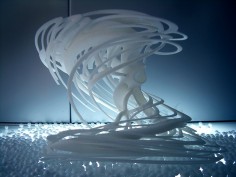MARCOS NOVAK
Turbulent Topologies
source: v2nl
Marcos Novak is an architect, artist, composer, and theorist who employs algorithmic techniques to design actual, virtual and hybrid intelligent environments. The self-described transarchitect is seeking to expand the definition of architecture by including electronic space, and originated the concept of liquid architectures in cyberspace and the study of a dematerialized architecture for the new, virtual public domain, the immersive virtual worlds.
Novak is professor at the Department of Architecture and Urban Design at UCLA, he is the founding director of the
Laboratory for Immersive Virtual Environments and the Advanced Design Research Program at the School of Architecture at the University of Texas at Austin, and a Fellow of the World Technology Network; and his (many) writings which combine architecture, music, art, computation, science, and/or technology include the seminal paper Liquid Architectures in Cyberspace (1991), transArchitecture: Against the Collapsing Radius of Fiction, and Transmitting Architecture: The transPhysical City (1996) – which became the theme of the XXIII World Congress of the UIA ((Union Internationale Des Architectes, 2008).
.
.
.
.
.
.
.
source: artitudeeu
Marcos Novak, founding father of the transarchitecture, which is not to be confused with a building with a short skirt and high heels, wig and lipstick, but rather has to be understood as a sort of crossing the screen until you get to the virtual space. Novak was the first to worry about how to use the purity of a pristine and ivory space; a space that would later influence the sounds, the architecture, the arts, the way we communicate. In fact, he is a successful architect who has taught in the best American universities since the early eighties.
Novak is a versatile artist who sees art as an inseparable whole of perspectives and explores the intermedia universe on several levels, through the basic levels of life, wherever it is lived. The result is the “liquid architectures”, come out from Novak’s study of virtual space, which has no gravity.
By transforming the virtual space into a physical space, everything seems fluid and fluctuating, a fusion between material and immaterial. Says the artist: “Gaston Bachelard used phenomenology to build a philosophical bridge between the science of space and the poetics of making significant places”.
“Turbulent Topologies” are a series of installations that Novak has produced in several cities as a definition of space through the matter of invisible architectures. The artist keeps saying: “‘Turbulent Topologies’ investigates the concept of “turbulence” as both a major condition of the global metropolis and as a formal principle governing the construction of both our external architecture and our inner psychologies. The exhibition will explore mixed layers and cross-currents, hidden links and sudden connections, flow networks and agitated stratifications. Through this exhibition, I propose a continuum between actual, virtual, and transactive space, both in form, and in inhabitation”.
Again connections, architecture, art projected on men and on the space they occupy, a mixing of invisible territories and virtual effects, creating a direct relationship to the nature, to the architectural expression, to what we are.
.
.
.
.
.
.
.
source: bevilacqualamasait
Marcos Novak è uno degli artisti e teorici più visionari del momento; si definisce un trans-architetto. I suoi saggi, le interviste, i progetti sono stati tradotti in più di 20 lingue e sono apparsi in più di 70 paesi. Il suo lavoro rifugge intenzionalmente dalle categorie tradizionali, disegnando sopra l’architettura musica e calcolo mettendo insieme influenze che provengono dall’arte, dalla scienza e dalla tecnologia. E’ universalmente riconosciuto come il teorizzatore dell’architettura nel cyberspazio, dell’approccio critico allo spazio virtuale come spazio architettonico e urbano e dell’uso in ambito architettonico e del design del calcolo generativo. Il suo saggio importante “Architettura liquide nel Cyberspazio” all’inizio degli anni novanta è stato tradotto in numerose lingue ed è presente nelle raccolte di testi sull’era digitale accanto a firme come quelle Charles Babbage, Alan Turino, Marshall Mcluhan.
Ha ideato molti termini ormai ampiamente diffusi tra i quali:
“transvergenza”, “transarchitetture,” “transmodernità,” “architettura liquida” , “musica navigabile”, “cinema abitabile”, “archimusica,” “allogenesi,” e molti altri, anticipando molti dei successivi sviluppi dell’arte, dell’architettura e musica digitale, nonché delle ricerche sulla realtà virtuale, alternativa, combinata, accresciuta. I suoi attuali interessi attuali ricerche coinvolgono le nano e bio tecnologie, ipotizzando che attualmente ci si trovi in una fase culturale caratterizzata da “The Production of the Alien,” sulla base di un parallelismo con l’idea rinascimentale del “Production of Man.”
Ha partecipato a numerose mostre internazionali, inclusa la 7° e la 9° Biennale di Architettura di Venezia, sia al padiglione internazionale principale che al settimo padiglione dove rappresentava la Grecia.
In relazione al ruolo centrale che ha avuto e che continua ad avere nel processo di accettazione e integrazione del digitale nell’architettura avanzata, e come componente del “DigitalReal”, un’importante mostra di architettura di livello internazionale ospitata dal DAM (Deutsches Architektur Museum, Frankfurt, Germany), è stato invitato a scrivere una cronologia insieme storico/biografica dello sviluppo dell’architettura digitale e il suo ruolo in essa.
Attualmente è professore all’Università della California a Santa Barbara, dove è membro del CNSI (Istituto della California per i Nanosistemi), del MAT (Arte Media Tecnologia) e del Word Technology Network.
Il XXIII Congresso mondiale dell’UIA (Unione internazionale degli architetti) svoltosi nel 2008 si intitolava “Transmitting Architecture” come il suo saggio pubblicato nel 1995.


